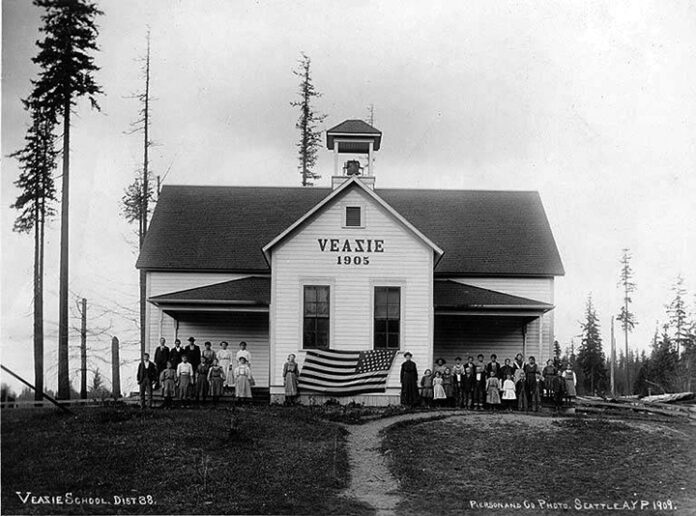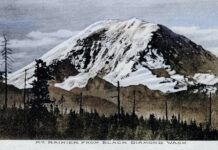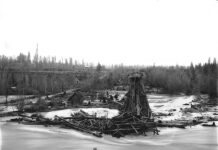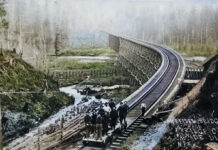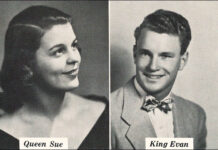The first school in Veazie was 10’ x 12’ and built of split cedar in 1885 along the Old Coal Creek Road. There were 14 pupils registered – Price, Myrtle, & Clyde Lee, Leslie & Hattie Steen, Melissa, Olo, & several other Forest children, Tom Wilson & Hattie Wilson, and Joe Standridge. John Blake was its first teacher, with pupils seated on cedar planks. School was only held in the summer as the building was not heated. The students were primarily children of the area’s earliest homesteaders that included Antone Anicich, Gustav Buckhorn, John Geareux, Robert M. Forest, Frederick Krause, John Standridge, Otto Tamm, Issac Wilson, and Joseph Fell Sr., for whom both Fell Hill and Fell Street were named.
In 1905, the Board of Directors of the Veazie School District #38 requested sealed bids due June 17 to select a contractor to build a new schoolhouse. The contract required construction to be completed by Sept. 30. Bids were submitted to Antonio G. Rocca, Clerk of District #39.
The building was quickly erected, as reported by the Enumclaw Courier in its Aug. 11, 1905 issue. “The new school house at Veazie is pleasantly situated, and the building itself now finished, is a credit to the district that owns it, and also to the skillful contractors who built it – Messrs. Bayes and Schomburg. We understand that Mr. George G. Barrett, as teacher, satisfied the Veazie people at the last school term, and will probably be retained for the next.” The old 1885 building was kept on site, neatly fenced off, and converted into a teachers’ residence.
Improvements to the new schoolhouse continued to be made during that first year. The Seattle Post-Intelligencer sponsored a contest to determine which King County school made the greatest improvements to the school premises during the 1905-1906 term. Veazie’s efforts were documented in the June 13, 1906 issue with praise offered for its lawn, flower beds, rose bushes, and various trees planted throughout the premises.
With help from railroad men, a 90-foot pole was erected, upon which flew a 10-foot flag that could be seen for miles, and is displayed in this photo. The P-I article concluded, “The work has been largely accomplished by the pupils’ personal efforts and by their parents. The board has, of course, contributed its share also.” The board of trustees consisted of Frank Stein, F.N. Anicich, and Antonio G. Rocca.
In 1907, a new coal vein was found in the A.G. Rocca mine and the town of Veazie held high hopes for continued growth. By then it had a rock quarry, a sawmill, and a new coal mine. None of those ventures prospered and the village withered. In 1931 an election was held to consolidate the Veazie School District into Enumclaw. By then, Veazie had only 10 students. The results in Enumclaw were 103 for and 27 against, while Veazie’s residents voted 38-1 for consolidation. Two of the last Veazie teachers were Edith M. Peterson and Mary Sullivan.
The schoolhouse was eventually converted into the Moose Hall of the Loyal Order, a fraternal and service organization founded in 1888 and headquartered in Mooseheart, Illinois. The building burned down circa 1967. A house now sits at the intersection of S.E. 392nd Street and the Veazie-Cumberland Road, perhaps 40 feet south of where the Veazie School / Moose Hall once stood.
This 1909 photo by Pierson & Company comes courtesy of JoAnne Matsumura, an Issaquah historian. The image was taken by one of many photographers assigned to capture images of Washington State to promote the Alaska Yukon-Pacific Exposition of the same year. The Expo’s fairgrounds were held on the University of Washington campus. Why the ‘Z’ in Veazie is backward atop the schoolhouse has never been satisfactorily explained.

